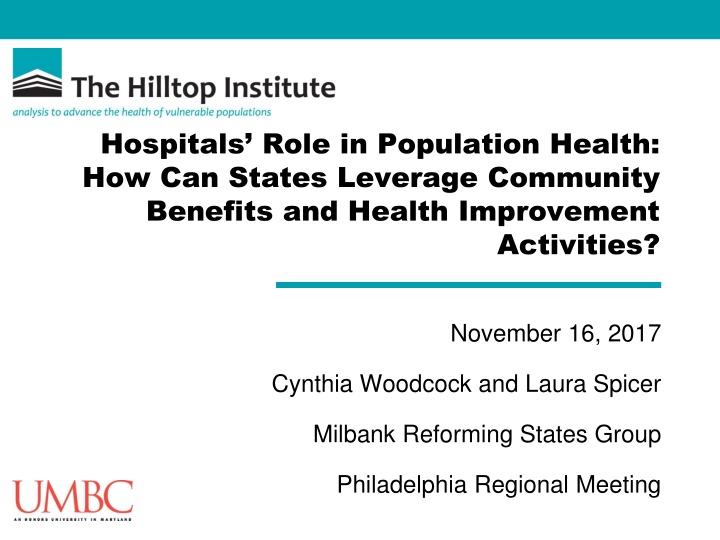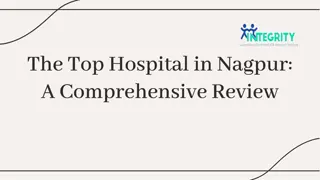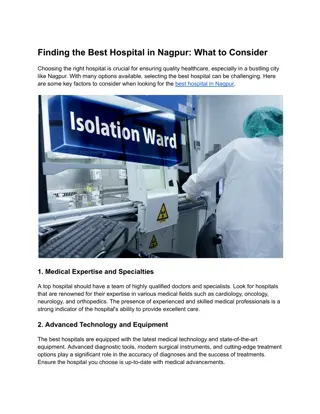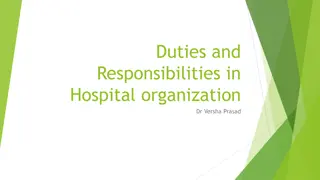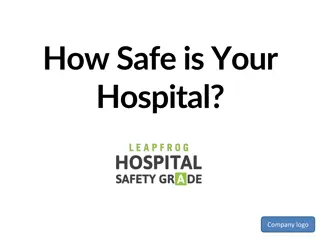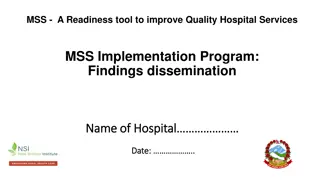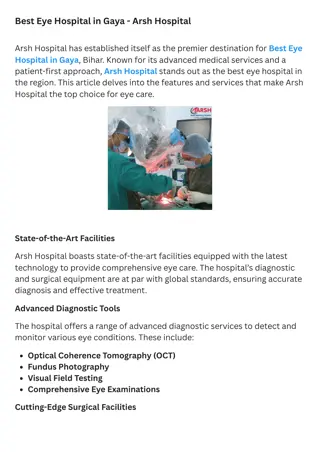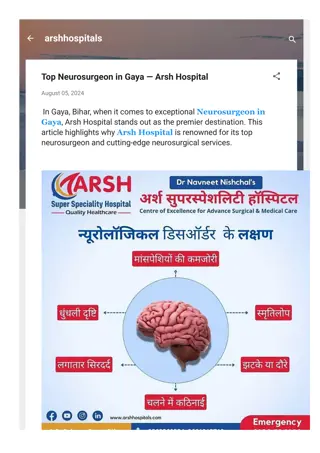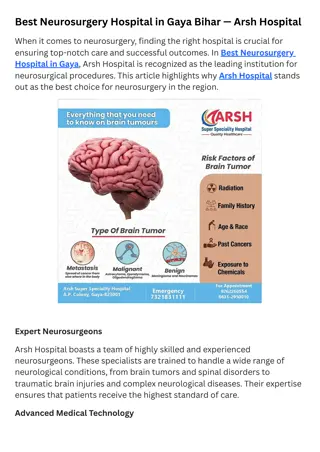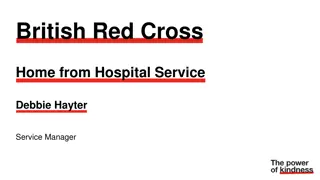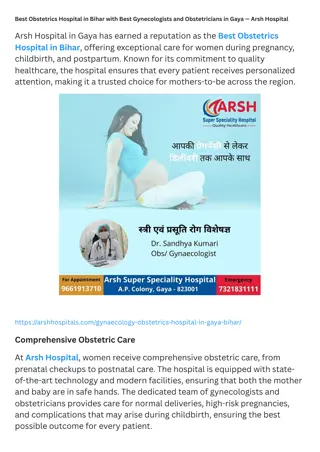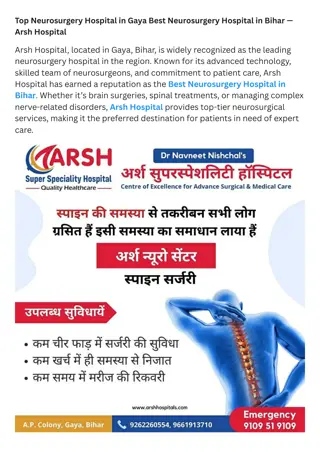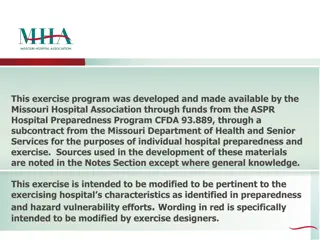Leveraging Hospital Community Benefits for Population Health Improvement
Focusing on the role of hospitals in improving population health, this presentation discusses factors contributing to hospitals' involvement, explores policy frameworks for Hospital Community Benefits (HCB), and evaluates the effectiveness of current federal and state policies. Key questions address hospitals' impact on community health, participation in population health goals, and the influence of new business models on state regulations. The importance of leveraging HCB through financial incentives and regulatory activities is emphasized.
Download Presentation

Please find below an Image/Link to download the presentation.
The content on the website is provided AS IS for your information and personal use only. It may not be sold, licensed, or shared on other websites without obtaining consent from the author.If you encounter any issues during the download, it is possible that the publisher has removed the file from their server.
You are allowed to download the files provided on this website for personal or commercial use, subject to the condition that they are used lawfully. All files are the property of their respective owners.
The content on the website is provided AS IS for your information and personal use only. It may not be sold, licensed, or shared on other websites without obtaining consent from the author.
E N D
Presentation Transcript
hilltop_left_w_tag Hospitals Role in Population Health: How Can States Leverage Community Benefits and Health Improvement Activities? November 16, 2017 Cynthia Woodcock and Laura Spicer Milbank Reforming States Group Philadelphia Regional Meeting
Introduction: Why we are focusing on the role of hospitals in improving population health There is a general expectation hospitals should be involved in population health improvement; today we will discuss factors that contribute to that expectation, and explore whether there is common ground on which to build policy and practice. Key questions to be covered: Nonprofit hospitals are required by federal and state policy to demonstrate community benefit and impact on community health. What are they contributing and is it effective? Hospitals are a significant component of health care utilization and cost. How are hospitals participating in accountable care models that include population health goals and metrics? Hospital systems are getting bigger and spreading across state lines. What is the impact of new hospital business models on state regulation and population health activities? -2-
Presentation Overview Current policy framework for Hospital Community Benefits (HCB) How are HCB measured and reported? Federal policy State policies State policy strategies to leverage HCB Financial incentives Regulatory activities Coordination of planning, measurement activities with hospitals -3-
Current Federal and State Policy Framework for Hospital Community Benefits -4-
HCB policy definitions start at the federal level The IRS is the regulating agency HCB are reported on IRS Form 990 Schedule H HCB are broadly defined as initiatives, activities, and investments undertaken by tax-exempt hospitals to improve health in the communities they serve -5-
Most HCB reported by hospitals to the IRS are charity care Percentage of Hospital Operating Budgets 7.0% 6.2% 6.0% 5.0% 4.0% 3.0% 2.0% 1.0% 1.0% 0.3% 0.0% Charity Care & Other Direct Patient Services Health Professions Education and Research Direct Community Health Improvement Simone R. Singh & Gary J. Young. Health Services Research. July 18, 2017. DOI: 10.1111/1475-6773.12739 -6-
Charity Care and Other Direct Patient Services consists of: Financial assistance for uninsured and underinsured patients Shortfall from Medicaid and any other means-tested government programs -7-
Direct Community Health Improvement consists of: Activities or programs aimed at improving community health Community benefit operations The need for the activity or program must be clearly documented (i.e., community health needs assessments [CHNAs], request from a local health department) -8-
Caveats and Limitations of Federal HCB Data Self-reported by hospitals Are instructions followed in a consistent manner? Does the IRS audit these data? Reported at system level; data for individual hospitals are not broken down Community Building is reported but does not count in the HCB calculation (e.g., housing, economic development, community support, environmental improvement, coalition building, community health improvement advocacy, work force development) -9-
The Affordable Care Act (2010) set forth new requirements that significantly broaden HCB responsibilities In addition to data on HCB expenditures, nonprofit hospitals must: Perform CHNAs at least every 3 years, taking into account input from persons representing community interests Adopt an implementation strategy to meet community health needs Have written financial assistance policies Report on needs being met, why identified needs are not being met, levels of charity care provided, and costs incurred for community benefit activities -10-
The 2014 IRS Final Rule* further clarifies and supports community health improvement activities by hospitals Community health needs broadly defined: hospitals must address financial and other barriers to care but also social determinants: prevention, nutrition, other social, behavioral, and environmental factors that influence health in the community CHNA implementation plans must demonstrate an impact that addresses the significant health needs identified in the hospital facility s prior CHNA(s) *See https://www.gpo.gov/fdsys/pkg/FR-2014-12-31/pdf/2014-30525.pdf. -11-
A new website will analyze and display Schedule H data from nonprofit hospitals Developed and sponsored by: RTI International Public Health Institute The Robert Wood Johnson Foundation Preview available at http://www.hospitalcommunitybenefit.org -12-
To monitor HCB, states can start by using the data reported to the IRS Collect hospital-specific Schedule H data in electronic form to facilitate aggregation and trending of financial data for planning, transparency, and compliance Collect, summarize, geo-map, and trend information from hospital CHNAs to align priorities, planning, and performance metrics -13-
States can also require additional HCB reporting as these 31 states have done Source: The Hilltop Institute, June 2016 Funded by: The Kresge Foundation http://www.hilltopinstitute.org/hcbp_cbl.cfm Source: The Hilltop Institute, June 2016 Funded by: The Kresge Foundation http://www.hilltopinstitute.org/hcbp_cbl.cfm -14-
Of the states represented at Philadelphia RSG meeting These states have their own reporting requirements: Connecticut requires hospitals that voluntarily develop community benefit programs to satisfy specific reporting requirements. Georgia requires hospitals to report charity care expenses. Massachusetts has voluntary guidelines that recommend annual community benefit reporting by hospitals. Montana requires nonprofit and for-profit hospitals to file annual financial reports that reflect expenses associated with charity care and services provided to Medicaid and Medicare patients. New Hampshire requires nonprofit hospitals and other health care charitable trusts to report community benefits provided the previous year as part of community benefit plans filed with the Director of Charitable Trusts. -15-
More state reporting requirements New York requires hospitals to report their costs of providing unreimbursed care and nonprofit hospitals to demonstrate their commitment to meeting community health needs. Ohio requires hospitals to report to the Department of Medicaid information on the identity and number of people who receive free care. Rhode Island requires hospitals to submit annual community benefit reports to the director of the Department of Health. South Carolina requires hospitals to report community benefits in connection with filing a certificate of need (CON) application. Tennessee requires nonprofit hospitals to report charity care. Virginia requires community benefit reporting by nonprofit hospitals that agree to provide community benefits as a condition of certificate of public need approval. -16-
In Maryland, Hilltop is helping the state build a new reporting tool The Maryland Health Services Cost Review Commission has responsibility for HCB reporting Population health improvement is a stated goal of Maryland s hospital All-Payer Model Hilltop is developing a web-based tool for data collection that will facilitate aggregation, analysis, and trending: Community benefit service area (for geo-mapping) Community Health Needs Assessments partners, identified needs, and priorities Community benefit staff roles/responsibilities External collaborations Community benefit initiatives -17-
Other data sources can augment required federal and state HCB reporting State Health Improvement Plan (SHIP) metrics Medicaid eligibility, claims, and encounter data All payer claims databases Data submitted for CON applications State-administered surveys Federal surveys (e.g., Census data, American Community Survey, Behavioral Risk Factor Surveillance System, National Health and Nutrition Examination Survey, National Health and Aging Trends Study) -18-
Discussion Questions What entities in your state work with hospitals on HCB data collection? What information is available about HCB either for specific hospitals or aggregate data? What are the trends in hospital HCB spending in your state? Hilltop s data about state laws were updated in June 2016. Has there been any legislative or regulatory action in your states that we may have missed? -19-
State Policy Strategies to Leverage HCB Spending and Activities -20-
The Triple Aim and Population Health Improvement Population health refers to the health outcomes of a group of individuals, including the distribution of such outcomes within the group many determinants of health, such as medical care systems, the social environment, and the physical environment, have their biological impact on individuals in part at a population level (Kindig & Stoddart, 2003). -21-
States are increasingly focusing on population health improvement as part of the Triple Aim State Health Improvement Plans (SHIP) State Innovation Model (SIM) projects Medicaid 1115 demonstration waivers Health homes Public health accreditation -22-
Many other forces are converging as well, prompting hospitals to redefine their role in the community Hospital business model shifting from volume to value Alternative payment models (e.g., accountable care organizations [ACOs]) Global revenue budgets Vertical and horizontal integration; hospitals and health systems becoming insurers Is there a shared vision in your state regarding the role of hospitals in population health improvement? -23-
Policy levers that states can use to organize and guide HCB Governance Financial incentives Regulation Collaboration -24-
Effective state-level governance is key State leadership for HCB policy at the state level: who s in charge? Is there a clear delineation of roles and responsibilities? Cross-agency collaboration (state and local health departments, attorney general s office) Stakeholder engagement and buy-in Community input Hospital input -25-
Policy levers that create financial incentives to improve population health Payment reform Value-based purchasing State grant programs -26-
Some examples of states using financial incentives Maryland: Global budgets for hospitals in 2014 as part of its All-Payer Model; transformation implementation grants, care redesign programs, and community health resources New York: State health improvement goals embedded in SIM and DSRIP payment reforms Medicaid ACOs: New Jersey: 2011 law required a 3-year demonstration project launching in 2015; partnership with Nicholson Foundation, which is sponsoring a learning network and infrastructure support to local coalitions Vermont: Medicaid Shared Savings Program launched in 2015; Vermont Next Gen ACO now under development (includes SDH performance measures) -27-
Some regulatory policy levers that promote population health improvement Require hospital HCB priorities to align with state priorities Require reporting and dissemination of hospital performance metrics Establish a threshold for HCB spending by hospitals -28-
Some examples of states using regulatory requirements Five states specify a minimum level of charity care that a nonprofit hospital must provide: Illinois and Texas specify the minimum to qualify for state tax exemption. Nevada specifies the minimum for nonprofit and for-profit hospitals that have at least 100 beds and are located in a county that has at least two licensed hospitals. Pennsylvania s Institutions of Purely Public Charity Act permits most nonprofit hospitals to choose from among seven alternative community benefit standards; six of the standards specify a minimum level of community benefits. Utah requires, as a condition of property tax exemption, a nonprofit hospital to contribute annual gifts to the community in an amount exceeding the value of its annual property tax liability. -29-
Some examples of states using regulatory requirements continued Maryland, Indiana, and Texas can impose civil penalties on hospitals for overdue community benefit reports. Indiana and Maryland hospitals must report on the effectiveness of community benefit initiatives. New York encourages hospitals to invest in and document to the IRS participation in NYS Prevention Agenda implementation activities. Massachusetts stresses setting measurable goals for community benefit programs and encourages using existing health status indicators for baseline measures. -30-
Some policy levers to promote collaborative planning at the local/state/regional levels State Health Improvement Plans (SHIPs) Hospital CHNAs required at least every 3 years States have the opportunity to align the timing and focus of these activities -31-
Some examples of collaborative planning New York: Department of Health called on hospitals to participate in a collaborative approach to community health assessment and planning; also to identify two New York State Prevention Agenda priorities and at least one health disparity to address with community partners. Utah: Updated its State Health Assessment to include input from partners beyond the Department of Health and local health departments; actively collaborating with Intermountain Healthcare system and more recently, the University of Utah to align and address priorities. -32-
Discussion Questions Is there a shared vision in your state regarding the role of hospitals in improving population health? Are you using any of these policy levers to encourage hospitals to address population health improvement through HCB activities and initiatives? Financial incentives Regulatory strategies Collaborative planning Who leads these efforts at the state level? Who are the partner agencies? -33-
Discussion Questions continued Are outside stakeholders interested in this work? If so, what is their role? What resources are available to help you? Data hospital reports, state data, federal data Partners state/local agencies, hospitals, community groups, foundations What other resources or tools would be helpful? How would you get started? -34-
About The Hilltop Institute The Hilltop Institute at the University of Maryland, Baltimore County (UMBC) is a nationally recognized research center dedicated to improving the health and wellbeing of vulnerable populations. Hilltop conducts research, analysis, and evaluations on behalf of government agencies, foundations, and nonprofit organizations at the national, state, and local levels. www.hilltopinstitute.org -35-
Contact Information Cynthia Woodcock Laura Spicer Executive Director Director, Health Reform 410.455.6274 410.455.6536 cwoodcock@hilltop.umbc.edu lspicer@hilltop.umbc.edu The Hilltop Institute University of Maryland, Baltimore County (UMBC) www.hilltopinstitute.org -36-
